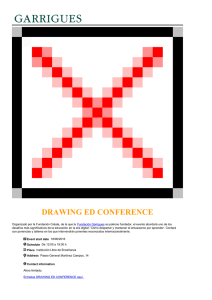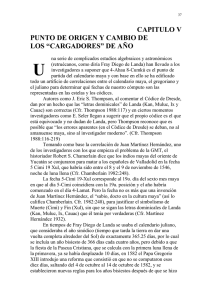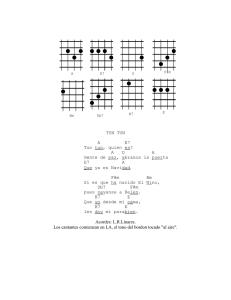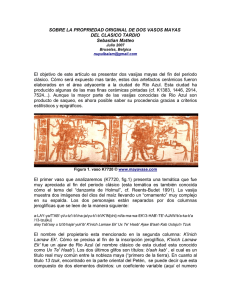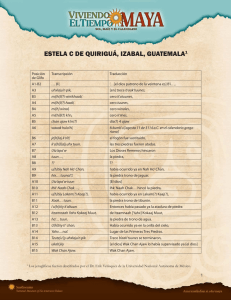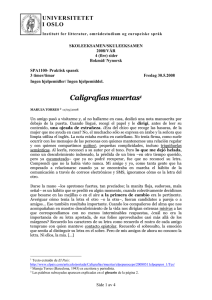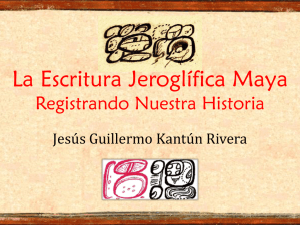Manual de los Monumentos de Copán, Honduras
Anuncio
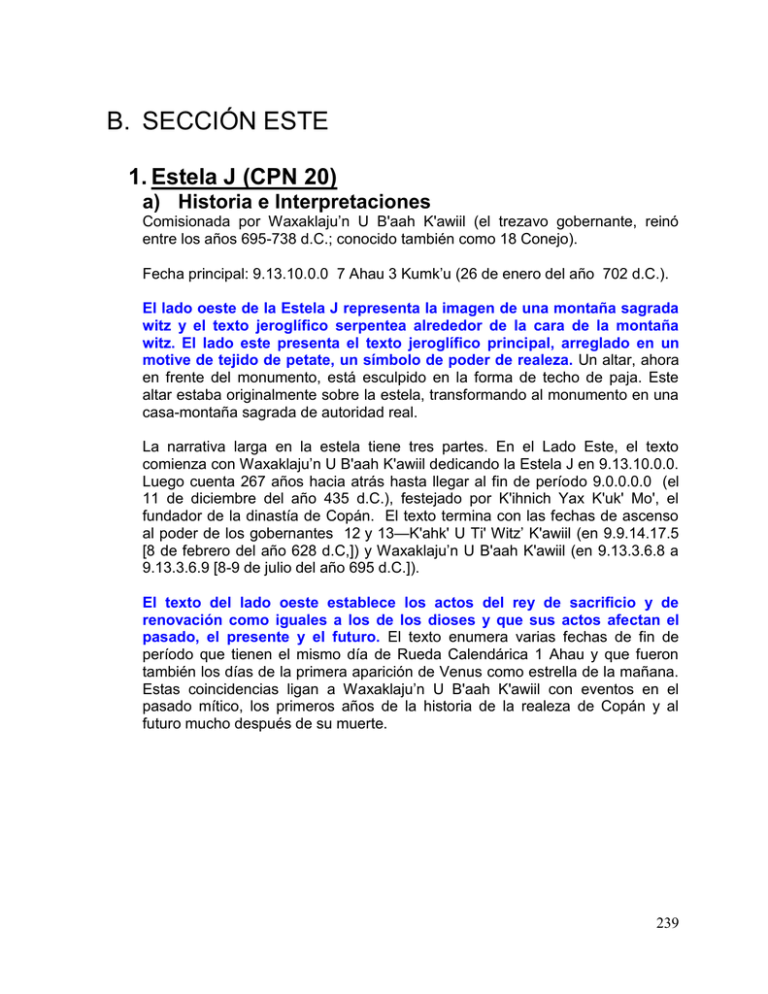
B. SECCIÓN ESTE 1. Estela J (CPN 20) a) Historia e Interpretaciones Comisionada por Waxaklaju‘n U B'aah K'awiil (el trezavo gobernante, reinó entre los años 695-738 d.C.; conocido también como 18 Conejo). Fecha principal: 9.13.10.0.0 7 Ahau 3 Kumk‘u (26 de enero del año 702 d.C.). El lado oeste de la Estela J representa la imagen de una montaña sagrada witz y el texto jeroglífico serpentea alrededor de la cara de la montaña witz. El lado este presenta el texto jeroglífico principal, arreglado en un motive de tejido de petate, un símbolo de poder de realeza. Un altar, ahora en frente del monumento, está esculpido en la forma de techo de paja. Este altar estaba originalmente sobre la estela, transformando al monumento en una casa-montaña sagrada de autoridad real. La narrativa larga en la estela tiene tres partes. En el Lado Este, el texto comienza con Waxaklaju‘n U B'aah K'awiil dedicando la Estela J en 9.13.10.0.0. Luego cuenta 267 años hacia atrás hasta llegar al fin de período 9.0.0.0.0 (el 11 de diciembre del año 435 d.C.), festejado por K'ihnich Yax K'uk' Mo', el fundador de la dinastía de Copán. El texto termina con las fechas de ascenso al poder de los gobernantes 12 y 13—K'ahk' U Ti' Witz‘ K'awiil (en 9.9.14.17.5 [8 de febrero del año 628 d.C,]) y Waxaklaju‘n U B'aah K'awiil (en 9.13.3.6.8 a 9.13.3.6.9 [8-9 de julio del año 695 d.C.]). El texto del lado oeste establece los actos del rey de sacrificio y de renovación como iguales a los de los dioses y que sus actos afectan el pasado, el presente y el futuro. El texto enumera varias fechas de fin de período que tienen el mismo día de Rueda Calendárica 1 Ahau y que fueron también los días de la primera aparición de Venus como estrella de la mañana. Estas coincidencias ligan a Waxaklaju‘n U B'aah K'awiil con eventos en el pasado mítico, los primeros años de la historia de la realeza de Copán y al futuro mucho después de su muerte. 239 1. Estela J (CPN 20) a) History and Interpretations Commissioned by by Waxaklaju‘n U B'aah K'awiil (the 13th ruler, reigned A.D. 695-738; previously known as 18-Rabbit). Principal date: 9.13.10.0.0 7 Ahau 3 Kumk‘u (26 January, A.D. 702). Stela J’s west side features the image of a sacred witz mountain, its hieroglyphic text meandering around the face of the witz mountain. The east side presents the main hieroglyphic text arranged in a woven mat motif, a symbol of royal power. An altar, now lying in front of the monument, is carved in the form of a thatched roof. Originally it was placed atop the stela, transforming the monument into a sacred mountain-house of royal authority. The stela‘s long narrative has three parts. On the East Side, the text begins with Waxaklaju‘n U B'aah K'awiil dedicating Stela J on 9.13.10.0.0. It then counts backwards 267 years to the 9.0.0.0.0 period-ending (on 11 December, A.D. 435) by K'inich Yax K'uk' Mo', the founder of Copán‘s dynasty. The text ends with the accession dates of the 12th and 13th rulers—K'ahk' U Ti' Witz‘ K'awiil (on 9.9.14.17.5 [8 February, A.D. 628]) and Waxaklaju‘n U B'aah K'awiil (on 9.13.3.6.8 to 9.13.3.6.9 [8-9 July, A.D. 695]). The west side’s text establishes the king’s acts of sacrifice and renewal as equal to those of the gods and that his acts affect the past, the present and the future. The text lists various period-ending dates that have the same Calendar Round day 1 Ahau and also were the first appearance of Venus as the morning star. These coincidences link Waxaklaju‘n U B'aah K'awiil to events in the mythological past, the early years of Copán‘s royal history, and the future long after his death. 240 b) Iconografía/Iconography Estela J, lado Oeste / Stela J, West side. Foto/ Photo: Ana Lucia Gastélum 241 Estela J, lado Oeste. Dibujo e identificación de algunos aspectos iconográficos. Stela J, West side. Drawing and identification of some iconographic aspects. Dibujo/ Drawing: Linda Schele 242 b) Escritura Jeroglífica/Hieroglyphic Writing Estela J. Dibujo, lado Oeste / Stela J. Drawing, West side. Diagrama de lectura Dibujo/ Drawing: Linda Schele 243 Dibujo de los jeroglíficos de la Estela J, lado Oeste y su traducción aproximada / Drawing of Stela J. Hieroglyphs, West side and their approximate translation. 1-AJAW ju'n ajaw 1 Ajaw 1 Ajaw ?? ?? ?? ¿? ?? ?? ?? ¿? 0-he-na mih[il] he'n 0 he‘n 0 he‘n 12-HAB'-ya lajcha' haab'[ii]y 12 haab' 12 haab' 1 3 5 7 9 2 4 6 8 UH-ti-ya uhtiiy it already happened ya sucedió YAX-K'UH-AJAW yax k'uh[ul] ajaw First Sacred Lord Primer Señor Sagrado ?? ?? ?? ¿? 0-WINIK-ji mih[il] winik[i]j 0 winik 0 winik 12-WINIKHAB' lajcha' winikhaab' 10 12 winikhaab' 12 winikhaab' 244 u-ti-ya u[h]tiiy it happened occurió 7-AJAW huk ajaw 7 Ajaw 7 Ajaw 3-??-OL hux ?? o[h]l hux ?? o[h]'l 3 ??-Ohl 3 ¿?-Ohl ?? ?? ?? ¿? ?? ?? ?? ¿? ?? ?? ?? ¿? 11 i-u-ti i u[h]ti 12 and then it happened y entonces occurió 13 CHOK-ko-CH'AJ chok ch'aaj 14 the incensescattering el esparcimientode-incienso 15 TAN-na-LAM ta[h]n lam 16 the half-diminishing la disminución a mitad 17 19 21 ?? ?? 18 ?? ¿? ya-ti-ji yatij 20 they accompanied him ellos le acompañaron a él ?? ?? 22 ?? ¿? 245 1-AJAW ju'n ajaw 1 Ajaw 1 Ajaw u-wa-b’a-ya u wab‟ay ?? ¿? ??-u-?? ??-u-?? ?? ?? ¿? ¿? ??-NAL ?? nal ?? Nal ¿? Nal 14- ?? chanlaju'n ?? 14 ?? 14 ¿? u-ti-ya u[h]tiiy it happened occurrió 23 25 27 29 31 33 u-ti-ya u[h]tiiy 24 it happened ocurrió wa-b’a-ya-u-KAB'ji-ya 26 wab‟ay u kab'jiiy ?? they made it happen ¿? ellos lo hicieron suceder ?? ?? 28 ?? ¿? ti-1-AJAW-TZUTZji-ya 30 ti ju'n ajaw tzuutzjiiy at 1 Ajaw he already finished en 1 Ajaw él ya terminó IK'-mi-?? I[h]k' ?? 32 Black ?? Negro ¿? 6-mi-NAL-1-AJAW wak mi[h] nal ju'n 34 ajaw Wak Mih Nal 1 Ajaw Wak Mih Nal 1 Ajau Ajaw 246 TZUTZ-yi-ya-13?? tzuutzuuyiiy huxlaju'n ?? he finished 13 ?? él terminó 13 ¿? u-??-??-mi u-??-??-Vm ?? ¿? 5-NIK-TE' ho' nik te' Ho' Nik Te' Ho' Nik Te' 35 37 39 ya-??-??-la ?? 36 ?? ¿? u-ti-ya u[h]tiiy 38 it happened sucedió AKAN?-na akan 40 Akan Akan 247 Estela J, lado Este / Stela J, East side. Foto/ Photo: Ana Lucia Gastélum 248 Estela J. Dibujo, lado Este / Stela J. Drawing, East side. Dibujo/ Drawing: Linda Schele 249 Estela J. Dibujo, lado Este / Stela J. Drawing, East side. Diagrama de lectura Dibujo/ Drawing: J.E.S. Thompson 250 Dibujo de los jeroglíficos de la Estela J, lado Este y su traducción aproximada / Drawing of Stela J. Hieroglyphs, East side and their approximate translation. ??-??-HAB' ??-??-haab' ?? of the year ¿? del año 9- ?? b'alu'n ?? 9 ?? 9 ¿? 10-HAB' laju'n haab' 10 Haab' 10 Haab‘ 0-K'IN mih k'in mih k'in 0 K'in 0 K‘in ?? ?? ?? ¿? 0 1 3 2 4 5 6 7 8 13-WINIKHAB' huxlaju'n winikhaab' 13 Winikhaab' 13 Winikhaab‘ 0-WINIK mih winik mih winik 0 Winik 0 Winik [7-AJAW] [huk ajaw] 7 Ajaw 7 Ajaw 251 18-HUL-ya waxaklaju'n huliiy 18 [days] arrived 18 [días] llegaron ??-??-ni-u-CH'OKK'AB'A' ??-??-Vn u ch'ok k'ab'a' ??-Vn it was the sprout name of ¿?-Vn fue el nombre jóven de 4-4-WINIK chan [k'in] chan winik 4 days 4 winik 4 días 4 winik no-jo-la-?? noj[o]'l ?? South ?? Sur ?? CH'OK Ch'ok the Sprout el Jóven 13- WINIKHAB' huxlaju'n winikhaab' 13 winikhaab' 13 winikhaab‘ 9 11 13 15 17 19 u-K'AL-??-ja u k'alaj 10 the ??-tying el atadura de ¿? WINIK-LAJUN-3??-OHL 12 winik laju'n hux ?? o[h]'l 30 [days] 3 ??-Ohl 30 [días] 3 ¿?-Ohl WA'-la-ji-ya wa'ljiiy 14 it stood up se paró K'AWIL K'awiil 16 K'awiil K‘awiil 0-he-na?-10-HAB' mih[il] he'n? laju'n 18 haab' 0 hen? 10 haab' 0 hen? 10 haab‘ CHAM-ya-K'AWILK'INICH 20 cham[aa]y k'awiil ki[h]nich he already took the k'awiil K'ihnich ya tomó al k‘awiil K‘ihnich 252 YAX-K'UK'-MO' yax k'uk' mo' Yax K'uk' Mo' Yax K‘uk‘ Mo‘ ??-ku-b'a-la-wi ??-kub'alaaw ?? ¿? u-CH'EN-ti-K'UH u ch'e'n ti k'uh the cave for the god(s) la cueva para los dios (es) k'u-yu-??-AJAW k'uy ?? ajaw K'uy ?? Ajaw K‘uy ¿? Ajaw u-CH'EN-ma-ka-pasa u ch'e'n maka[j] pasa[j] his cave he covered he opened su cueva él cierró él abrió 21 23 25 27 29 3-WITZ-AJAW-wa hux witz[a'] ajaw 22 Hux Witza' Ajaw Hux Witza‘ Ajaw ?? ?? 24 ?? ¿? 4-TE’-AJAW 9K'AWIL 26 chan te‟ ajaw b'alu'n k'awiil Chan Te‘ Ajaw B'alu‘n K'awiil Chan Te‘ Ajaw B‘alu‘n K‘awiil i-??-??-?? i ?? 28 and then ?? y entonces ¿? HUN-??-yaWITE'?-na 30 hu'n ??-Vy wite' naa[h] Headband ?? Wite' Naah la Cinta de Cabeza el ¿? Wite‘ Naah erosionado eroded erosionado eroded 31 32 253 erosionado eroded erosionado eroded 33 18-K'AN-a-(si-ya) waxaklaju'n k'ana[siiy] 18 K'anasiiy 18 K‘anasiiy K'AK'-[u]-TI'-WITZ’ k'a[h]k' [u] ti' witz‟ K'ahk' U Ti' Witz‘ K'ahk' U Ti' Witz‘ u-TZ'AK-AJ u tz'akaj it was the count of era la cuenta de 11-WINIK-ji-ya b'uluch winikjiiy 11 winik 11 winik 3-YOP-HUN-na-yichi-NAL hux yop hu'n yichnal the 3 Yop Hu‘n in the presence of el 3 Yop Hu‘n en la presencia de 35 37 39 41 43 34 CHUM-mu-la-yaAJAW-wa 36 chumlay [ta] ajaw[il] he sat into the lordship se sentó en el reino K'AWIL-la k'awiil 38 K'awiil K‘awiil 12-he-na? lajcha' he'n? 40 12 he‘n? 12 he‘n? CHAM-?? cham ?? 42 the ?? taking el tomo de ¿? u-MAM-K'UH-u-saku-K'UH 44 u mam k'uh saku[n] k'uh his grandfather god his older brother god su dios de abuelo su dios de hermano mayor 254 u-ti-ya-3-wi-ti-kiCHAN-CH'EN-na u[h]tiiy hux witik chan ch'e'n it happened at Hux Witik sky-cave se occurió en Hux Witik cielo-cueva 1-TE'-MOL-CHUMla-ya-ti-AJAW-wa ju'n te' mol chumlay ti ajaw[il] on 1 Mol he sat into the lordship en 1 Mol se sentó en el reino 45 47 7-LAMAT huk lamat 46 7 Lamat 7 Lamat 18-[u-B'AHK'AWIL] 48 waxaklaju'n [u b'aah k'awiil] Waxaklaju‘n U B'aah K'awiil 255 Estela J, lado Norte / Stela J, North side. Foto/ Photo: Ana Lucia Gastélum 256 Estela J. Dibujo, lado Norte / Stela J. Drawing, North side. Dibujo/ Drawing: Linda Schele 257 Dibujo de los jeroglíficos de la Estela J, lado Norte y su traducción aproximada / Drawing of Stela J. Hieroglyphs, North side and their approximate translation. A 0-he-na-0- WINIK-10HAB'-6- WINIKHAB' mih[il] he'n mih[il] winik laju'n haab' wak winikhaab' 0 he‘n 0 winik 10 haab' 6 winikhaab' 0 he‘n 0 winik 10 haab' 6 winikhaab' 1-HAB'-i-yu-wa-la ju'n haab' iyuwal 1 Haab' and then 1 Haab' y entonces i-yu-wa-la-CHAM-wa-tziku iyuwal chama‟w tzi'k and then taken is the ?? y entonces tomado es el ?? YAX-??-?? yax ?? ?? Yax ?? ?? Yax ¿? ¿? CHAK-5-HAB' chaa[h]k ho' haab' Chahk 5 Haab' Chahk 5 Haab' 6-HAB'-i-yu-wa-la wak haab' iyuwal 6 Haab' and then 6 Haab' y entonces 1 2 3 4 5 6 B 1 2 3 4 5 6 TZUTZ-jo-ma-u-10- ??-ti7-AJAW-18-CHAK-AT tzuutzjo‟m u laju'n ?? ti huk ajaw waxaklaju'n chakat shall be completed 10th ?? at 7 Ajaw 18 Chakat será terminado el 10o ¿? en 7 Ajaw 18 Chakat e-pi-2-HAB' epi cha' haab' it arrived at the end 2 Haab' llegó al final 2 Haab' 3-HAB'-i-yu-wa-la hux haab' iyuwal 3 Haab' and then 3 Haab' y entonces 4-HAB'-pu-ku-xa chan haab' puku'x 4 Hab' poured out is the 4 Haab' vaciado es i-yu-wa-la-u-ho'-TUN-ni iyuwal u ho'tuun and then the 5th tuun y entonces el 5o tuun WINIK-??-?? winik ?? ?? 20 ?? ?? 20 ¿? ¿? 258 7-HAB'-i-yu-wa-la huk haab' iyuwal 7 Haab' and then 7 Haab' y entonces i-yu-wa-la-YAX-tzi-ja-ya iyuwal yax tzijay and then Yax Tzijay? y entonces Yax ¿Tzijay? 7 8 7 8 CHAM-xa-yu-??-na-8HAB' cham[a]x yu-??-Vn waxak haab' taken is his ?? 8 Haab' se tomado es su ¿? 8 Haab' ??-TE’-9-HAB'-ya ?? b‟alu‟n haab' ?? 9 Haab' ¿? 9 Haab' 259 Estela J, lado Sur / Stela J, South side. Foto/ Photo: Ana Lucia Gastélum 260 Estela J. Dibujo, lado Sur / Stela J. Drawing, South side. Dibujo/ Drawing: Linda Schele 261 Dibujo de los jeroglíficos de la Estela J, lado Sur y su traducción aproximada / Drawing of Stela J. Hieroglyphs, South side and their approximate translation. A ??-ja ??-Vj ?? ¿? i-yu-wa-la-TAN-LAM iyuwal ta[h]n lam and then the halfdiminishing y entonces la mediadisminuyendo sa-ka-xa-TE'-?? sakax te' ?? searched? Is the Te' ?? ¿busado? es el Te' ¿? SAK-k’i-b’a-13-HAB' sak k‟iib‟-huxlaju'n haab' the Sak K‘iib‘ 13 Haab' Sak K'iib‘ 13 Haab' u-wa-WAY-ya-14HAB' uway chanlajun haab' its portal 14 Haab' su portal 14 Haab' ??-15-HAB' ?? ho'laju'n haab' ?? 15 Haab' ¿? 15 Haab' 1 2 3 4 5 6 B AJAN-na-10-HAB' ajan laju'n haab' 1 Ajan 10 Haab' Ajan 10 Haab' 11-HAB'-i-yu-wa-la b'uluch haab' iyuwal 2 11 Haab' and then 11 Haab' y entonces 12-HAB'-HUL-ya lajcha' haab' huliiy 3 12 Haab' it arrived 12 Haab' llegó i-yu-wa-la-ma-ka-xa iyuwal makax 4 and then closed is y entonces cerrado es i-yu-wa-la-ja-la iyuwal jal 5 and then y entonces i-yu-wa-la-wi-5-TUN-ni iyuwal wi['l] ho' tuun 6 and then the last 5 tuun y entonces el último 5 tuun 262 16-HAB'-i-yu-wa-la waklaju'n haab' iyuwal 16 Haab' and then 16 Haab' y entonces 7 CHAM-xa-cho-b'a-ka cham[a]x cho[j] b'ak 7 taken is the jaw-bone tomado es la mandibula eroded erosionados eroded erosionados 8 8 263 Traducción Libre Lado Este "La cuenta del año era 9 Baktunes 13 Katunes 10 Tunes 0 Uinal 0 Kin en 7 Ahau ... fueron 18 [días] desde que la luna arribó cuando fue el atadura de ... ... fue el nombre jóven del mes lunar de 30 [días] en 3 Kumk‘u y 4 días 4 uinales antes se levantó en el sur ... K'awiil Ch'ok 0 hen‘? 10 tunes 13 katunes antes él ya tomó el K'awiil K'ihnich Yax K'uk' Mo' Hux Witza' Señor él ... la cueva para los dioses Chan Ajaw, B'alu‘n K'awiil, K'uy ... Ajaw, y él ... su cueva él cerró él abrió la Cinta de Cabeza, el ... él de Wite' Naah… en 18 Kayab se sentó en el reino K'ahk' U Ti' Witz‘ K'awiil la cuenta era 12 días 11 uinales el amarre de ... el 3 Yop Hu‘n en la presencia de su Mam K‘uh y su Sakun K‘uh esto occurrió en Hux Witik Cielo-Cueva en 7 Lamat 1 Mol se sentó en el reino Waxaklaju‘n U B'aah K'awiil". Lado Oeste "En 1 Ahau y ocurrió ... por el Primer Señor Sagrado ... ... 0 he‘n 0 uinal 12 tunes 12 katunes antes y sucedió entonces ocurrió en 7 Ahau el esparcimient-de-gotas en 3 Kumk‘u la media-disminución 264 por ... ... ... ellos le acompañaron ... ... en 1 Ahau y occurrió el ... ... ellos le hicieron pasar ... ... ... en 1 Ahau terminó 14 Baktun el Negro ... ocurrió en Wak Mih Nal en 1 Ahau terminó 13 Baktun ... ... ocurrió en Ho' Nik Te' Akan" Lado Norte "0 kin 0 uinal 10 tunes 6 katunes después será completado el 10o Baktun en 7 Ahau 18 Sip [y entonces la cuenta del año empezó con] 1 Tun y entonces llegó el fin 2 Tun y entonces tomado es ... 3 Tun y entonces fue Yax ... ... 4 Tun [y entonces] envasado es Chaahk 5 Tun y entonces fue el 5o tuun 6 Tun y entonces fue 20 ... ... 7 Tun y entonces tomado es su ... 8 Tun y entonces fue Yax Tzijay ... Te' Nal 9 Tun Lado Sur [y entonces] ... Ajan 10 Tun y entonces fue la media-disminución 11 Tun y entonces buscado es el Te' ... 12 Tun 265 y entonces llegó Sak K'iib‘ 13 Tun y entonces cerrado es su apertura 14 Tun y entonces ... uinal 15 Tun y entonces fueron los últimos 5 tuun 16 Tun y entonces tomado es la mandibula…" Free Translation East Side "The count of the year was 9 Baktuns 13 Katuns 10 Tuns 0 Uinal 0 Kin on 7 Ahau … it was 18 [days] since the moon arrived it was the …-tying … was the sprout name of 30 [days] lunar month on 3 Kumk‘u [and] 4 days 4 uinals earlier it stood up at the south … K'awiil Ch'ok 0 he‘n? 10 tunes 13 katunes earlier he already took the K'awiil K'ihnich Yax K'uk' Mo' Hux Witza' Ajaw he … the cave for the god(s) Chan Ajaw, B'alu‘n K'awiil, K'uy … Ajaw, and he … their cave he covered, he opened the Headband, the … he from the Wite' Naah… at 18 Kayab he sat as into the lordship K'ahk' U Ti' Witz‘ K'awiil it was the count of 12 days 11 uinales the …-taking the 3 Yop Hu‘n in the presence of his Mam K‘uh and his Sakun K‘uh it happened at Hux Witik Sky-Cave on 7 Lamat 1 Mol he sat into the lordship Waxaklaju‘n U B'aah K'awiil" 266 West Side "on 1 Ahau and it happened … by the First Sacred Lord … … 0 he‘n 0 uinal 12 tunes 12 katunes earlier and it happened then it happened on 7 Ahau the incense-scattering on 3 Kumk‘u the half-diminishing by … … … they accompanied him … … on 1 Ahau and it happened the … … they made it happen ……… on 1 Ahau he finished 14 Baktun the Black … it happened at Wak Mih Nal on 1 Ahau he finished 13 Baktun …… it happened at Ho' Nik Te' Akan" North Side "0 kin 0 uinal 10 tuns 6 katuns later it will be finished the 10th Baktun on 7 Ahau 18 Sip [and then the count of the year began with] 1 Tun and then the end arrived 2 Tun and then taken is the … 3 Tun and then it was Yax … … 4 Tun [and then] poured out is Chaahk 5 Tun and then it was the 5th tuun 6 Tun and then it was 20 … … 7 Tun) 267 and then taken is its … 8 Tun and then it was Yax Tzijay … Te' Nal 9 Tun South Side [and then] … Ajan 10 Tun and then it was half-diminishing 11 Tun and then searched is the Te' Pik 12 Tun and then it arrived Sak K'iib' 13 Tun and then closed is its opening 14 Tun and then … the uinal 15 Tun and then it was the last 5 tuun 16 Tun and then taken is the jaw-bone…" 268 C. SECCIÓN CENTRAL 1. Estela 3 (CPN 41) a) Historia e Interpretaciones Explicación La Estela 3 fue comisionada por K'ahk' U Ti' Witz‘ K'awiil para conmemorar dos eventos. El primero fue la 'siembra' de la estela misma en 9.10.19.5.0 (28 de Enero, 652 d.C.) y dedicada a K'ahk' Ti' Chan, un dios que se menciona en otras inscripciones de Copán. El segundo evento registra el nacimiento de Yax Chiit (otro dios) y varios rituales por K'ahk' U Ti' Witz K'awiil en 9.10.19.5.10 (7 de Febrero, 652 d.C.). 1. Estela 3 (CPN 41) a) History and Interpretations Explanation Stela 3 was commissioned by the twelfth ruler K'ahk' U Ti' Witz‘ K'awiil to commemorate two events. The first one was the 'planting' of the stela in 9.10.19.5.0 (28 January, A.D. 652) and dedicated to K'ahk' Ti' Chan, a deity mentioned in the inscriptions of Copan. The second event records the birth of Yax Chiit (another deity) and several rituals made by K'ahk' U Ti' Witz‘ K'awiil in 9.10.19.5.10 (7 February, A.D. 652). b) Iconografía Estela 3, lado Sur La Estela 3 fue la primera estela con doble personaje que se hizo en Copán, una clase de escultura que posteriormente lo copió su hijo Waxaklaju‘n U B‘aah K‘awiil. Las estelas con doble personaje por lo general tienen imágenes contrastantes del gobernante en cada lado, por ejemplo, en la Estela C Waxaklaju‘n U B‘aah K‘awiil aparece como un hombre joven por un lado y viejo por el otro. Desafortunadamente, muchos de los detalles pictóricos de la Estela 3 están erosionados, de modo que no sabemos qué clase de oposición gemela pudo haberse presentado. Los detalles que sobreviven de las figures ancestrales en la cima de cada lado del monumento puede que indiquen la oposición de vida y muerte o del mundo 269 humano y el inframundo. En el lado sur, estas figuras llevan peinados esqueléticos y tienen marcas de ―muerte‖ en sus mejillas. En el lado norte, sin embargo, los ancestros llevan peinados completamente carnosos y no llevan marcas de ―muerte‖. Otra oposición puede ser el del acto del sacrificio de sangre, en el lado sur, y el resultante portal abierto del reino sobrenatural en el lado norte. En el lado sur, el gobernante lleva un peinado del dios jaguar-Pax, y se supone un acto de sacrificio de sangre por la presencia del dios perforador que lleva en su faja y por las gotas de sangre en su taparrabo. En el lado norte, el peinado del gobernante representa a un pájaro (demasiado erosionado para identificarlo) y su taparrabo está adornado con in ícono relacionado con el portal sobrenatural abierto por medio del sacrificio de sangre y por la visión de búsqueda. b) Iconography Stela 3, South side Stela 3 was the first double-portrait stela made at Copán, a type of sculpture later copied by his son Waxaklaju‘n U B‘aah K‘awiil. Double-portrait stelae typically have contrasting images of the ruler on each side; for example, on Stela C Waxaklaju‘n U B‘aah K‘awiil is portrayed as young on one side and old on the other. Sadly, many of the pictorial details of Stela 3 are eroded and thus we do not know what kind of paired opposition may have been present. The surviving details of the ancestor figures at the top of each side of the monument may indicate the opposition of life and death or of the human world and the underworld. On the south side, these figures wear skeletal headdresses and have ―death‖ markings on their cheeks. On the north side, however, the ancestors wear fully fleshed headdresses and have no ―death‖ markings. Another opposition may be that of the act of blood sacrifice, on the south side, and the resulting opened portal to the supernatural realm on the north side. On the south side the ruler wears a jaguar-Pax god headdress, and blood sacrifice is implied by the perforator deity worn at his belt and the drops of blood on his loincloth. On the north side the ruler‘s headdress features a bird (too eroded to identify), and his loincloth is adorned with an icon related to the supernatural portal opened via blood sacrifice and vision quest. 270 c) Iconografía/Iconography Estela 3, lado Sur / Stela 3, South side. Foto/ Photo: Ana Lucia Gastélum 271 Estela 3, lado Sur. Dibujo e identificación de algunos aspectos iconográficos. Stela 3, South side. Drawing and identification of some iconographic aspects. Dibujo/ Drawing: Barbara Fash 272 Estela 3, lado Norte / Stela 3, North side. Foto/ Photo: Ana Lucia Gastélum 273 Estela 3, lado Norte. Dibujo e identificación de algunos aspectos iconográficos. Stela 3, North side. Drawing and identification of some iconographic aspects. Dibujo/ Drawing: Barbara Fash 274 c) Escritura Jeroglífica/Hieroglyphic Writing Estela 3, lado Este / Stela 3, East side. Foto/ Photo: Ana Lucia Gastélum 275 Estela 3. Dibujo, lado Este / Stela 3. Drawing, East side. Dibujo/ Drawing: Barbara Fash 276 Dibujo de los jeroglíficos de la Estela 3, lado Este, y su traducción aproximada / Drawing of Stela 3 hieroglyphs, East side, and their approximate translation. A ??-HAB’ ??-haab‟ ?? of the year ¿? del año 9-??-10- WINIKHAB' b‟alu‟n ?? laju'n winikhaab' 9 ?? 10 Winikhaab' 9 ¿? 10 Winikhaab' 19-HAB’-5-WINIK b‟alu‟nlaju‟n haab‟ ho' winik 19 Haab‘ 5 Winik 19 Haab‘ 5 Winik 1 2 3 277 0-K’IN-?? mih[il} k‟in ?? 0 K‘in ?? 0 K‘in ¿? 4 ??-??-ya-u-??-ji-a-po-ya’ ??-Vy u-??-Vj apoya‟ ?? Apoya' ¿? Apoya' 5 u-CHOK-K’AB’A’-10-WINIK12-AJAW u chok k‟ab‟a‟ laju‟n winik lajcha ajaw it was the sprout name of the 6 30 [days] 12 Ajaw era el nombre joven de los 30 [días] 12 Ajaw ??- K'AN-a-si-ya 13-WINIK?? ?? k'anasiiy huxlaku'n winik ?? K'anasiiy 13 winik ?? ¿? K'anasiiy 13 winik ¿? 7 278 ??-hi-11?-WINIKHAB'-tz'apa-ja-u-LAKAM-TUN-ni-li ??-Vh b'uluch winikhaab' tz'a[h]paj u lakamtuunil ?? 11th winikhaab' was planted into the ground the big stone of ¿? 11º winikhaab' fue plantada en la tierra la gran piedra de ??-??-??-ki-ni?-??-??K'AK'-TI'-CHAN-?? ?? kin-?? k'a[h]k' [u] ti' chan ?? ?? kin-?? K'a[h]k' U Ti' Chan ¿? kin-¿? K'a[h]k' U Ti' Chan 8 9 279 Estela 3, lado Oeste / Stela 3, West side. Foto/ Photo: Ana Lucia Gastélum 280 Estela 3. Dibujo, lado Oeste / Stela 3. Drawing, West side. Dibujo/ Drawing: Barbara Fash 281 Dibujo de los jeroglíficos de la Estela D, lado Oeste, y su traducción aproximada / Drawing of Stela D hieroglyphs, West side, and their approximate translation. B ??-HAB’ ??-haab‟ ?? of the year ¿? del año 9-??-10-WINIKHAB' b‟alu‟n ?? laju'n winikhaab' 9 ?? 10 Winikhaab' 9 ¿? 10 Winikhaab' 19-HAB’-5-WINIK' b‟alu‟nlajun haab‟ ho' winik 19 Hab‘ 5 Winik 19 Hab‘ 5 Winik 1 2 3 282 10-K'IN-?? laju'n k'in ?? 10 K'in ?? 10 K'in ¿? 4 ??-hu-li-ya-??-a-po-ya ?? huliiy ?? apoya' ?? since it arrived ?? Apoya' ¿? desde que llegó ¿? Apoya' ??-WINIK-u-CH'OKK'AB'A'-?? ?? winik u ch'ok k'ab'a' ?? ?? twenty it was the sprout name of ?? ¿? veinte era el nombre joven de 5 6 283 9-OK-4-??-OL-SIH-ya-jaYAX-CHIT b'alu'n ok chan ??-o[h]'l sihyaj yax chiit 9 Ok 4 ??-Ohl he born Yax Chit 9 Ok 4 ¿?-Ohl nació Yax Chiit ??-??-ja-??-ko-NAH-OKNAL-K'AK'-TI-WITZ’K'AWIL ??-Vj ??-ok naah ook nal k'a[h]k' [u] ti' witz‟ k'awiil he ?? Naah Ook Nal K'ahk' U Ti' Witz‘ K'awiil él ¿? Naah Ook Nal K'ahk' U Ti' Witz‘ K'awiil IK'-??-pi-WINIKHAB'-ch'aho-ma-u-ko-b'o-wa-?? ii[h]k' ??-Vp ch'a winikhaab' ch'aho'm u k'obo'w the B'ack Copan [Lord] 2 Winikhaab' Youth he engendered? el [Señor] del Copan Negro 2 Winikhaab' Joven engendró ¿? 7 8 9 284 Traducción Libre "La cuenta del año era 9 Baktunes 10 Katunes 19 Tunes 5 Uinales 0 Kin ... ... Apoya' fue el nombre joven del [mes lunar] de 30 [días] en 12 Ahau 13 Kayab [en] ... 11º katun fue plantada en la tierra la gran piedra de ... K'a[h]k'Ti' Chan." "La cuenta del año fue 9 Baktunes 0 Katunes 19 Tunes 5 Uinales 10 Kines ... desde que llegó [la luna] ... Apoya' ... fue su nombre joven del [mes lunar] de 30 [días] en 9 Ok 4 Kumk‘u nació Yax Chiit él ... Naah Ook Nal [lo hizo] K'ahk' U Ti' Witz‘ K'awiil el [Señor] del Copán Negro 2 Katun Joven él engendró ...." Free Translation "The count of the year was 9 Baktuns 10 Katuns 19 Tuns 5 Uinals 0 Kin … … Apoya' was the sprout name of the 30 [days] lunar month on 12 Ahau 13 Kayab [in] … 11th katun was planted into the ground the big stone of … K'a[h]k' Ti' Chan." "The count of the year was 9 Baktuns 10 Katuns19 Tuns 5 Uinals 10 Kins … … since [the moon] arrived … Apoya' … was the sprout name of 30 [days] lunar month on 9 Ok 4 Kumk‘u he born Yax Chiit he … Naah Ook Nal [he made it happen] K'ahk' U Ti' Witz‘ K'awiil the B'ack Copan [Lord] 2 Katun Youth he engendered …." 285 2. Altar K (CPN 22) a) Historia e Interpretaciones Explicación El Altar K conmemora la dedicación de una estructura desconocida (posiblemente el muro-cerco de una tumba, aunque hasta el momento no se pueden leer los jeroglíficos) en 9.12.16.10.8 (2 de noviembre 688). Es interesante que, sin importar lo que haya sido el objeto o el edificio, éste pertenecía a una persona élite de nobleza quien aparentemente se llamaba Tiwohl B‘ahlam. Él era un sajal, título que se refería a gobernantes secundarios y a miembros de nivel bajo de la élite, incluyendo a aquellos responsables de recoger tributo para el gobernante supremo. Aunque este título con frecuencia se menciona en otras inscripciones, ésta es su única utilización en las inscripciones de Copán. El texto continúa con un ritual raramente registrado que se desarolló según las palabras de unas especialistas que simplemente se llamaron ‗los jóvenes‘. El ritual también incluyó la bebida de pulque fermentado por el contemporáneo gobernante de Copán K‘ahk‘ U Ti‘ Witz‘ K‘awiil. 2. Altar K (CPN 22) a) History and Interpretations Explanation Altar K commemorates the dedication of an unknown structure (possibly a tombenclosure, although the glyphs cannot be read at present) in 9.12.16.10.8 (2 November, 688). Interestingly, whatever was the object or building, it was owned by a non-royal elite person who seemingly was named Tiwohl B'ahlam. He was a sajal, a title referring to secondary rulers and lower-level members of the elite including those responsible for collecting tribute on behalf of the paramount ruler. Although this title is frequently mentioned in other inscriptions, this is its only use in the inscriptions at Copan. The text continues with a rarely recorded ritual which went according to the words of some ritual specialist here simply called 'youngsters. The ritual also included the drinking of fermented pulque by the contemporaneous Copan ruler K'ahk' U Ti' Witz‘ K'awiil. 286 b) Escritura Jeroglífica/Hieroglyphic Writing Altar K , lado Sur / Altar K, South side. Foto/ Photo: Ana Lucia Gastélum Altar K. Dibujo, lado Sur / Altar K. Drawing, South side. Dibujo/ Drawing: Gustavo Valenzuela 287 Dibujo de los jeroglíficos del Altar K, lado Sur, y su traducción aproximada / Drawing of Altar K hieroglyphs, South side, and their approximate translation ??-HAB' ?? haab' ?? of the year ?? del año 12- WINIKHAB' 12 winikhaab' 12 Winikhaab' 12 Winikhaab' 10-WINIK laju'n winik 10 Winik 10 Winik 3-LAMAT hux lamat 3 Lamat 3 Lamat ?? ?? ?? ¿? A1 A2 C1 C2 E1 B1 B2 9-?? b'alu'n ?? 9 ?? 9 ¿? 16-HAB' waklaju'n haab' 16 Haab' 16 Haab' 8-K'IN waxak k'in D1 8 K'in 8 K'in 9-CH'AM-K'UH TI'-na b'alu'n cham k'uh ti' D2 [hu'n] 9 Cham K‘uh was the speaker of the book 9 Cham k‘uh fue el hablador del libro 2-??-K'AL-ja [u] cha' ?? k'alaj E2 it was its 2 ?? tying fue su 2 atadura de ¿? 288 Altar K, lado Este / Altar K, East side. Foto/ Photo: Ana Lucia Gastélum Altar K. Dibujo, lado Este / Altar K. Drawing, East side. Diagrama de lectura 289 Foto de los jeroglíficos del Altar K, lado Este, y su traducción aproximada / Photo of Altar K hieroglyphs, South side, and their approximate translation ?-CHAPAT ?? chapaa[h]t ?? Centipede ?? Ciempiés K'AL?-li-B'ALUN k'aal b'alu'n 29 [days] 29 [días] F1 F2 ??-9-TZ'AKAJAW ?? b'alu'n tz'ak H1 ajaw ?? the manyordered-lords ¿? los muchos señores en ordern ??-TUN-na-hi ?? tuun naah ?? stone house H2 ¿? piedra casa G1 G2 u-K'AB'A' u k'ab'a' it was its name esto fue su nombre 16-YAX-SIHOM?-ma waklaju'n yax siho'm 16 Yax Siho‘m 16 Yax Sih‘om I1 ??-wa-?? ??-Vw ?? ?? [the Resplendent?] ¿? [¿el Resplandeciente?] I2 T'AB'-yi-u-? t'ab'[aa]y u ?? it got smoothed the ?? of se acicaló el de ¿? 290 Altar K, lado Norte / Altar K, North side. Foto/ Photo: Ana Lucia Gastélum Altar K. Dibujo, lado Norte / Altar K. Drawing, North side. Dibujo/ Drawing: Gustavo Valenzuela 291 Dibujo de los jeroglíficos del Altar K, lado Norte, y su traducción aproximada / Drawing of Altar K hieroglyphs, North side, and their approximate translation TIWOL?-la-B'ALAM?? tiwo[h]'l? b'a[h]lam ?? Tiwohl B'ahlam ?? Tiwohl B'ahlam ¿? J1 yi-ta-hi-sa-ja-la yitaah sajal they accompanied him [the] sajal ellos lo acompañaron J2 [el] sajal K1 K2 SAK-TE'-AJAW-waB'AH-TE' sak te' ajaw b'aah te' White Tree Lord First Spear [Lord] Señor del Árbol Blanco, [Señor] del Primer Lanza AJ-TI'-yu-tu-ku aj ti' yutuk he of Ti' Yutuk él de Ti' Yutuk yo-OK-TE' ITZAMma yokte' itzam[naaj] L1 the support of Itzamnaaj el soporte deI Itzamnaaj ya-a-la-ji-ya y‟aljiiy M1 [as] they had said it [como] ellos lo dijeron ch’o-ko-WINIK-ki ch'ok winik the Youngsters los Jóvenes i-UK' i uk' M2 and he was drunk y él fue borracho ti-yu-ta-la ti yutal from the fruity del afrutado L2 N1 N2 SAK-SA'-chi-hi sak sa‟ chih the white ground pulque el atole polvido blanco 292 Altar K, lado Oeste / Altar K, West side. Foto/ Photo: Ana Lucia Gastélum Altar K. Dibujo, lado Oeste / Altar K. Drawing, West side. Dibujo/ Drawing: Gustavo Valenzuela 293 Dibujo de los jeroglíficos del Altar K, lado Oeste, y su traducción aproximada / Drawing of Altar K hieroglyphs, West side, and their approximate translation *YAX-POLAW?-wa*YAX-WINIK yax polaw? yax winik O1 the first ocean, the first man el océano primero, el hombre primero K'AK'-u-TI' k‟a[h]k u ti‟ K‘ahk‘ U Ti‘ K‘ahk‘ U Ti‘ K'UH-?-pi-AJAW k‟uh[ul] ??-Vp ajaw Sacred Copan Lord Sagrado Señor de Copan 4-WINIKHAB'-ch'aho-ma chan winikhaab‟ ch‟aho‟m 4 Winikhaab‘ Youth 4 Winikhaab‘ Jóven O2 Q1 R2 P1 P2 Q1 R2 K'AWIL-? k‟awiil ?? K‘awiil ?? K‘awiil ?? WITZ’-K'AWIL witz‟ k‟awiil Witz‘ K‘awiil Witz‘ K‘awiil no-ho-la?-KAL-TE' noh[o‟]l kal[o‟m] te‟ Southern Kalomte‘ Kalomte‘ del Sur 4-WINIKHAB'AJAW-wa chan winikhaab‟ ajaw 4 Winikhaab‘ Lord 4 Winikhaab‘ Señor 294 Traducción Libre “La cuenta del año era 9 Baktunes 12 Katunes 16 Tunes 10 Uinales 8 Kines en 3 Lamat [cuando] 9 Cham K‘uh fue el hablador del libro ... cuando fue la segunda atadura de ¿? ...[Mih K‘uh] Chapaaht fue el nombre jóven del [mes lunar] de 29 [días] en 16 Yax [cuando] ... los muchos señores en orden (la dinastía) [cuando] ... La Casa del ... [el Resplandeciente] ... Piedra se acicaló el ... de Tiwohl B‘ahlam ... el Señor del Árbol Blanco el Señor de la Primera Lanza ellos lo acompañaron el sajal Aj Ti' Yutuk el Soporte del Itzamnaaj como dijeron los Jóvenes y él fue borracho del atole blanco y afrutado el océano primero, el hombre primero el K‘awiil ... ... K‘ahk‘ U Ti‘ Witz‘ K‘awiil Sagrado Señor de Copán el Kalomte‘ del Sur el 4 Katun Jóven el 4 Katun Señor.‖ Free Translation “ The count of the year was 9 Baktuns 12 Katuns 16 Tuns 10 Uinals 8 Kins on 3 Lamat [when] 9 Cham K‘uh was the speaker of the book … it was its second … tying … [Mih K‘uh] Chapaaht was the sprout name of the 29 [days] lunar month on 16 Yax [when] … the many ordered-lords (the dynasty) [when] … [the Resplendent?] … Stone House it got smoothed the … of Tiwohl B'ahlam the White Tree Lord the First Spear [Lord] they accompanied him [the] sajal Aj Ti' Yutuk 295 the Support of the Itzamnaaj [as] they had said it the Youngsters and he was drunk from the fruity white ground pulque the first ocean, the first man … K‘awiil K‘ahk‘ U Ti‘ Witz‘ K‘awiil Sacred Copan Lord the Southern Kalomte‘ the 4 Katun Youth the 4 Katun Lord.‖ 296

